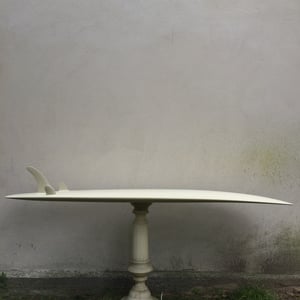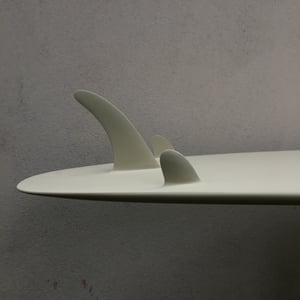6'8 Progressive Modern Hull
980,00 €

From 6'8 to 7'4
Passive progression towards a design, modern, in the making ... which constitutes how to combine the timeless flow of a convex hull with a touch of modernity. Modernity? Characteristically opposing tradition. Certainly, but how do you act on a design while retaining its main asset? I studied dozens of possibilities, but it was clear that I had to keep the same bottom shape of a classic hull: convex on the front 2 thirds and flat on the rear third. With a tucked under edge on rail from the fins to the tail. I then looked for substantial outline modifications, to change the pivot of the rail, rebalance the curves, to have a more important pivot point on the rear foot, with a wide point centred in the middle of the board unlike the hull classic, which has its wide point well in front of the middle of the board.
It also appeared on a classic hull with a wide nose (generally between 18 to 19 inches) that this nose width was beneficial on fast waves with a wall where the surfer favours a fast trim, on the front end of the board to gain speed. But if the surfer wants to change his curve and return to the pocket when the wave lost tension, then the width of the nose becomes bulky. The widest part of the rail at the nose tended to catch in the water and sink half of the board before the cut back was completed, and the destination not yet reached. Reducing the nose width, moving the wide point back and therefore moving the hull back. Moving the fins back and favouring the back foot control, were, therefore, the key ingredients in revisiting the Hull. A new hull with back foot control, but with the hull present on the front third of the board, so if the wave dictates, it is possible to centralize control on the middle of the board and make the hull act. It was also obvious to think of a different fin set up. If a deep and flex fin accentuates the length and voluptuousness of a bottom turn or a cutback, it can sometimes make the changes of direction too slow and poorly adapted to the wave. A shallower fin, with less rake, straighter, and a little more rigid would cause tighter, more radical turns. To compensate for the loss of fin depth and therefore prevent the tail (which is quite large in itself) to chase and slip, two small thin sides ( trailers ) are added to the 8-inch central fin. The trailer fins act as a grip but their sizes are not overpowering and leave the pure sensation of a single fin. For these trailer fins, I was inspired by a classic D from the end of the 50s. For the outline of the board, I was inspired by the boat plans present in Lindsay Lord's book, Naval Architecture of Planing Hulls. But also Ted Spencer's stubby, or at least Shane's White Kites. The PMH Tail rocker is very slightly more accentuated than a classic hull. The nose rocker is the same as a point break Hull.




